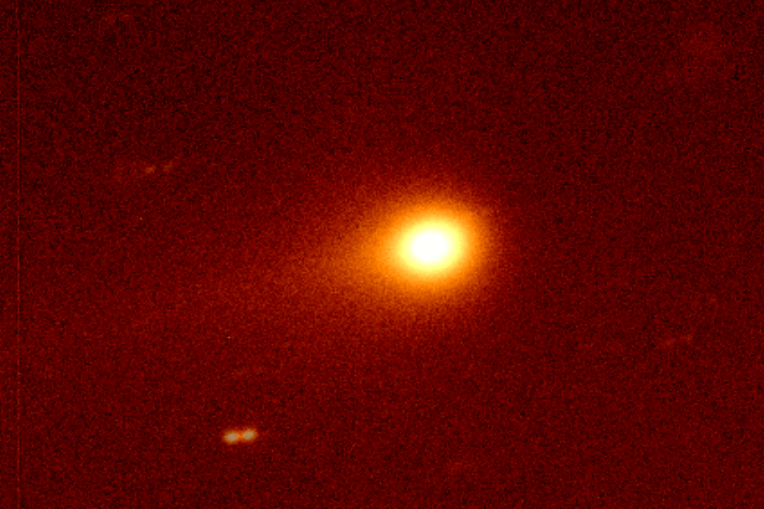Astronomers confirm the presence of water on interstellar comet 3I/ATLAS
Astronomers confirm water on interstellar comet 3I/ATLAS, revealing how cosmic travelers may spread life’s ingredients.

3I/ATLAS photographed by the Gemini South telescope on 27 August 2025, revealing a tail pointed away from the Sun. (CREDIT: Wikipedia / Elena Sabbi, Brian Lemaux, Siyi Xu, Leilani Lozi, and Manuel Paredes as part of program GS-2025B-DD-103)
For millions of years, a frozen traveler drifted in silence through the stars, carrying secrets from another world. This summer, that interstellar visitor—now known as 3I/ATLAS—passed through our solar system, only the third interstellar object known to exist.
When astronomers at Auburn University trained NASA's Neil Gehrels Swift Observatory on it, they uncovered something incredible: the unmistakable ultraviolet signature of hydroxyl, a chemical byproduct of water vapor.
Unveiling Water from the Stars
Auburn team leader astrophysicist Zexi Xing used Swift's ultraviolet vision to detect faint emissions from 3I/ATLAS's coma and thereby confirm that the comet is releasing water. The results revealed that the object releases about 1.36 × 10²⁷ water molecules per second, or about 40 kilograms per second. Even more surprisingly, this activity occurred when the comet was almost three times as distant from the Sun as Earth is, a region too cold for most comets to lose water.
That degree of activity places 3I/ATLAS in rarefied company. There have been few comets that have exhibited this sort of distant water sublimation, in which the sunlight is so weak that it will not melt ice directly from the surface. The finding means that the water in the comet is instead transported by small grains of ice that are shot out into space, where even weak sunlight can vaporize them.
The Ultraviolet Advantage
Swift's Ultraviolet/Optical Telescope gave astronomers an edge that ground-based telescopes cannot: the ability to see through the Earth's atmosphere, which blankets most ultraviolet light and hides these delicate signals from the eye.
While in orbit, Swift observed two sets of ultraviolet images of 3I/ATLAS during the summer of 2025—once in late July and again mid-August. During the time between the two observations, the hydroxyl signal nearly doubled, demonstrating that water production increased dramatically as the comet neared the Sun.
Because the spacecraft can't aim at moving targets, scientists used a ploy called motion correction, slicing the data into 30-second pieces to avoid blurring the images with the comet's light. After stacking the exposures together, the scientists observed a foggy envelope of gas around the nucleus—a clear sign that water was being released into space.
Measuring the Flow
Determining how much water was being emitted took a process of steps. The researchers started by approximating how many hydroxyl molecules are within a 10-arcsecond radius of the nucleus and found about 2.2 × 10³⁰ molecules in July and 4.2 × 10³⁰ as of mid-August. Based on sunlight-driven models, they estimated how quickly water was breaking up, and that told them to estimate their final production rate.
To be accurate, the scientists accounted for the manner in which the dust on the comet scatters sunlight, adjusted for what astronomers call "reddening." Without that adjustment, faint ultraviolet radiation could be mistaken for scattered light instead of actual chemical action.
If water found was actually coming directly from the surface of the comet, then at least 7.8 square kilometers—or over 8%—of its surface must be actively emitting vapor. That is incredibly high for a body whose nucleus radius is about 2.8 kilometers.
The majority of comets in our solar system only have 3–5% of its surface active at one time or another. That amount of activity indicates that 3I/ATLAS could have an atypically ice-dense surface or that it's shedding volatile dust grains that continue evaporating after being expelled.
Interstellar Visitors Compared
This is a major breakthrough for astronomers studying interstellar travelers. The first guest, 1I/'Oumuamua, was devoid of any signs of gas activity. The second one, 2I/Borisov, released water and carbon monoxide in roughly equal quantities before later going back to a carbon monoxide–dominant mixture. Now, 3I/ATLAS has revised the script again, with intense water activity away from the Sun and very little sign of other volatile gases.
Infrared measurements also revealed frozen grains that orbited around it, with the suggestion that much of its water is derived from suspended material rather than the solid core. By comparing the infrared and ultraviolet data, scientists were able to validate that the emissions were from water—not nickel or carbon monoxide, which can mimic similar signs.
Each interstellar comet possesses a tale of where it was formed. 'Oumuamua was rocky and dry, Borisov was carbon-rich, and ATLAS is water-active at never-before-seen distances. Such diversity indicates that planetary systems other than our own Sun form comets under vastly different conditions.
Dennis Bodewits, Auburn physics professor and co-author of the study, simplified it thus: "When we see water—or even its faint ultraviolet echo—coming from an interstellar comet, we're reading a message from outside our planetary system. It says the chemical building blocks for life are not unique to our own."
A Window into Planet Formation
The discovery also reveals how comets can transport water and organic molecules between galaxies. If bodies like 3I/ATLAS can endure frozen water for extended interstellar missions, they might be the delivery vehicles for the ingredients of life among stellar systems. The comet's unusual chemistry—water-rich but cyanogen-poor (CN)—could mean that it formed out of material within a carbon-deprived environment near a youthful, metal-poor star.
As Xing noted, "Each interstellar comet that has come by so far has been a surprise. 'Oumuamua was dehydrated, Borisov was carbon monoxide-rich, and now ATLAS is losing water at a distance where we didn't expect it. Each one is rewriting what we thought we knew about the formation of planets and comets around stars."
3I/ATLAS had not been visible since but will return after mid-November and give astronomers another chance to observe how its activity changes near the Sun. Continuing observations with space telescopes could decide whether its water activity remains static or other gases take center stage when solar heating intensifies.
Practical Implications of the Research
Findings such as these open our eyes to the ways water—and perhaps the building blocks of life—move through the universe.
By establishing that interstellar bodies can preserve ice on timescales that stretch for millions of millions of years, the study gives us a deeper understanding of how solar systems begin and evolve.
It adds weight to the possibility that comets are cosmic messengers, delivering water and organic compounds from one nascent world to the next, potentially giving life a foothold in more than one corner of the universe.
Research findings are available online in The Astrophysical Journal Letters.
Related Stories
- Astronomers intrigued by odd light emitted by interstellar visitor 3I/ATLAS
- Is interstellar object 3I/ATLAS an alien probe? Harvard physicist sparks debate
- NASA Deep Space Network guides astronomers in the search for alien intelligence
Like these kind of feel good stories? Get The Brighter Side of News' newsletter.
Joseph Shavit
Science News Writer, Editor-At-Large and Publisher
Joseph Shavit, based in Los Angeles, is a seasoned science journalist, editor and co-founder of The Brighter Side of News, where he transforms complex discoveries into clear, engaging stories for general readers. With experience at major media groups like Times Mirror and Tribune, he writes with both authority and curiosity. His work spans astronomy, physics, quantum mechanics, climate change, artificial intelligence, health, and medicine. Known for linking breakthroughs to real-world markets, he highlights how research transitions into products and industries that shape daily life.



